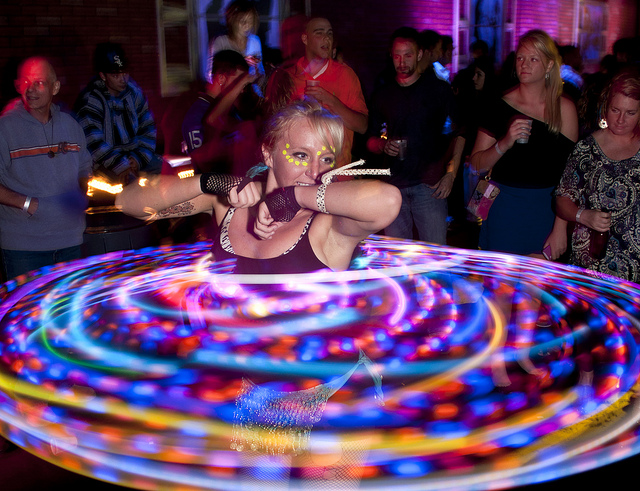I have been reading recently about the “conscious rave” movement.
Before the term “conscious uncoupling” was coined, The Guardian wrote about “conscious clubbing” in 2001.
While clubs are usually a place to “escape, take an E, dance, flirt and forget,” conscious clubbing is all about, well, conscious, clean fun. Clean being the operative word.
You’re sober, and so is everyone else.
In theory, it sounds like something you would read about on Gwyneth Paltrow’s Goop. But in reality, it isn’t something for the faint-hearted. It takes a lot of guts to really get into and let go. It’s one thing to dance alone in your bedroom, it’s another thing to dance in a room full of 250 people, sober. Feeling exposed, feeling judged.
I had my first, eye-opening experience about 18 months ago in Ubud, Bali. Every Saturday night, the Yoga Barn holds a class (well, really it’s a dance party) called “ecstatic dance.”
I was staying at the Yoga Barn, so sat at the alcohol-free cafe and watched all the people arrive on their motor-bikes. Everyone was dead sober (I secretly thought, and hoped, people would bring flasks). Everyone congregated upstairs at the yoga hall. The music was incredibly loud and the lights were off. I mostly watched, and it was fascinating.
Some were genuinely high off the dancing, like they were actually on drugs. Some were in truly meditative states, with their eyes closed, swaying around the room. Some couples were getting pretty hot and heavy. Other were dancing and sweating, like it was the biggest workout of their lives.
The mood was electric. I danced with a friend, but watched a couple of older solo females just completely let go, and felt a twinge of jealousy. At the time, I desperately wished I could do the same. I wished I could walk into the middle of crowd, alone, and swing my hands in the air and close my eyes and dance my heart out.
I don’t know what stopped me. Usually I love to dance, and even if I’m sober, it’s the comforting thought that everyone else isn’t that makes it okay.
But when it’s a collective crew of over 200 people who are all sober, you begin to feel naked. Your body freezes up.
By the end of the two hours, I had relaxed slightly, but I still couldn’t leave my friend and just dance alone like everyone else. To me, “ecstatic dance” is a collective dance that you do alone, like yoga. But the high you get from ecstatic dance is much different from either yoga or meditation. It’s a freeing feeling, an endorphin rush, a high similar to drugs—but only when you can truly let yourself go and stop worrying about your surroundings.
Like in meditation, it requires quieting our mind.
Later in the year I travelled to one of my favourite places, a small bay in Koh Phangan famous for its day-long dance parties (check out the Guy’s Bar’s rain dance). People do come sober to these parties, but there is never a collective group of people who come just to dance without any mind-altering substances.
Ecstatic dance is an experience like yoga, it takes practice and discipline. It’s an experience I wish I had more often, but unlike yoga, it isn’t offered in the mainstream—and it makes me wonder, what are we all so scared of?
While in Thailand over summer I met a number of Londoners who I have become Facebook friends with. Since then, the phrase “Morning Gloryville” keeps popping up on my Facebook feed. It wasn’t until I began researching the topic of “conscious clubbing” that I realised this isn’t yet another alcohol-fueled festival. Rather, it is an ecstatic dance party to, as their motto states, “rave your way into the day.”
People attend before work—it is a kind of “breakfast raving” with smoothies and coffee, and alcohol and drugs strictly off-limits. When most people are pressing snooze, glued to their iPhone on the train, or reading the newspaper over toast, the ravers at Morning Gloryville are starting their day with an endorphin rush, just like the one you get from a night out dancing.
Imagine if you could start every morning like this before heading to work?
It might be hard at first, it might take some discipline and some quietening of your mind, but the beauty and the art of ecstatic dance is that once you completely let yourself go, you’ll feel more energized than any morning spent on the treadmill.
Author: Hannah Furst
Editor: Emily Bartran
Photo: Colin Gordon/Flickr







Read 1 comment and reply